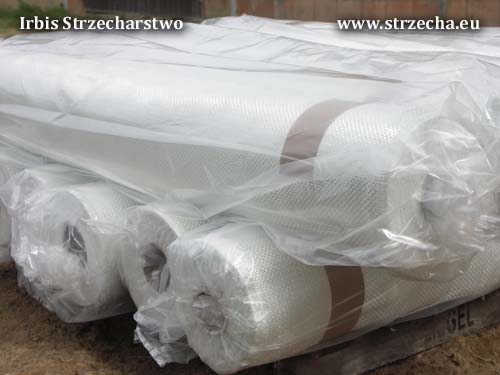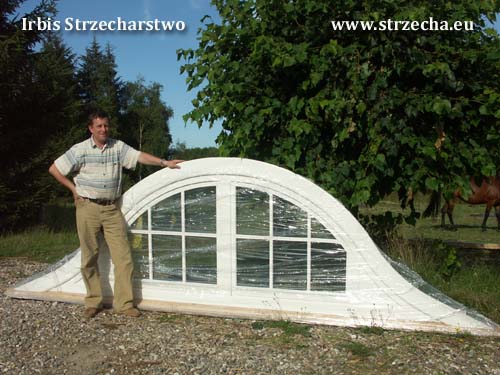Assembly materials
IRBIS Thatching - we use only the chromium-nickel wire - so-called "stainless steel wire" with a thickness of 1 mm. The type of alloy guarantees the preservation of its mechanical properties at high temperatures, which hinders the spread of fire during a fire (ordinary galvanized wire is solved under the influence of temperature like a string, causing an increased supply of oxygen to the fire source!). We offer packages with a weight close to 20kg and 10kg

In Poland, it is probably only with us that you can buy shear screws - what is sold here as so-called shear screws is a return to primitivism and confirmation of the need to organize a thatch guild. The weave screws offered by us have holes for the TORX bit, allowing screwing in without the need to check the screw, or a newer version: ASSY, which eliminates damage to the screw coating. The offer includes screws packed in cartons of 2,000 or 2,400 pieces

Covering materials
Straw rye - to this day popular cover of roofs in some areas of England, called "long straw". Excellent material, allowing to obtain rounded shapes of airguns and hoods. Dimensions: 120-150cm, grown without nitrogen fertilization which provides resistance to accelerated rot. We usually use bundles with a circumference of 70cm, tied in two places. The straw in the bundle is cleaned, combed out of dry grass and leaves, which facilitates laying, but also in the finished rhodium allows for faster drying and better air circulation.

Water reed in "roof" bundles - 60 cm perimeter, length in the following compartments: 120-150 cm, 160-180 cm, 190-220 cm. Roof reed bundles are packed in 50 or 25 pieces of belotte. It is important that before belaying (steel strapping in three, sometimes in four places) reed in bundles is dry - about 15% humidity. The cane is harvested (mowed) in winter, but it is converted into roof bundles in a later period and must be protected / sheltered from precipitation by that time. The beam should be "full" - it can not change the volume under pressure

Materials on the ridges
Oak, hand-split, with a profiled end. Dimensions: length 110cm. The goats are used as standard in making a straw or heather ridge, consisting of a foundation and filling with a proper material. The whole is fastened with a fine galvanized mesh and PVC coated. We fasten the goats being the subject of the offer at equal intervals to the ridge thus made. It is the most typical ridge for Eastern Europe and Scandinavia. Interestingly: I have not seen such a solution anywhere in Germany.

Heather mowed on plantations, pressed into cubes with approximate dimensions 40x60x80cm is a ridge filling material. There is also "heather straw" compressed in cubes, which is obtained by threshing the heather, in order to obtain seeds for the pharmaceutical industry. Of the two materials, the latter is more easily available, but its durability is unfortunately smaller. The heather straw also differs in color - it is brown ore due to the fact that during the threshing all green parts of the plant are separated.

Polymer-bituminous membrane on a polyester support. Thickness 1mm, length 25m, width 1.08m. It retains its properties at a temperature of +100 to -30 degrees Celsius. has a very good puncture resistance, which is a basic condition for the ridge substrate. Its advantage is parodiffusion, which allows you to get rid of excess moisture that can condense from the air ventilating the walls, roof and attic, leaving the system just in the ridge! The bottom of the membrane is a polypropylene nonwoven.

"Hazel staples" and slates of various lengths - this is an irreplaceable material when making straw and English ridge. They are made by hand by splitting into a few pieces of hazelnut with a length of about 85cm. The shale thus obtained is sharpened at both ends and twisted in the center so as not to break the wood fibers. Staples are bundled with 50 pieces and then packed in 4 such bundles (200 pieces). The minimum quantity of wholesale purchase is 6000 items (pallet). Small quantities can be purchased at the retail price, however, there may be shortages periodically.

Security thatched firebreak
Sepatec membrane is part of the Sepatec system, which has passed the exam as: insulation of the wooden roof structure against fire. The material from which it is made enables the air to circulate, allowing free removal of excess moisture from the cover layer, but limits the access of oxygen to the burning thatch, thereby reducing the intensity of fire. Polymer-glass fiber effectively locates fire on the surface, preventing its transfer to the inside of the roof section. An excellent way to increase the safety of thatch

Fire Retardant - a measure for fire-proofing thatch surface, reducing the possibility of ignition and at the same time prolonging its durability. The product meets the requirements of many international fire protection standards in the field of roofing, including the European standard EN 13501-5 and the Broof classification requirements! The manufacturer determines the drying time for one hour. The agent is present in 25 and 50 kg containers. For effective protection of 1 m2, 500 g of impregnate should be used, at a working pressure of 5 atmospheres.

Protection / removal of moss
If we want to extend the longevity of thatch, or we have to fight with the moss appearing on the mans, I recommend a solution popular in Denmark - placing copper in the form of fiber in the ridge material! The oxide formed on its surface, washed away by rainwater flowing down, effectively stops the development of moss and algae. The effectiveness of this solution is determined by the active surface of the material used (1 meter of copper tape, 6 square meters). The material is spread under heather or straw filling the ridge or window sills. Research conducted in Denmark confirmed that after several years of application of copper fiber, the concentration of copper oxide on the roof surface, below the place of application, effectively inhibits the development of mosses and lichens

If unfavorable conditions prevail around the roof (many trees, other objects close, lack of air flow, permanent shade of the roof, etc.) or copper oxide has not started to work, it is necessary to use methods that will protect the roof against the expansion of mosses, algae, lichens and large seedlings trees. It is important that if you want to prolong the durability of the coverage, do not lead to its accelerated degradation. This effect occurs after using the most easily available aggressive, caustic agents that, when applied to the surface, will destroy moss, spores and the outer part of thatch. We use a biodegradable product which undergoes rapid decomposition and effectively protects the roof for up to 3 years, destroying selectively moss, algae and lichen: MOS-ALGEN REMOVER

Thatchers tools
Sheathing packs: 1. float (15x24cm) for spreading reeds, for large areas; 2. float (21x32cm) for leveling large surface of thatch; 3. float (13x32cm) for eaves aligning; 4. float (14x19cm) for the final correction of small decorative elements and smaller canopies. The thickness of the material from which the float is made is 16mm. Thanks to the unique method of execution, the floats are relatively light and at the same time have walls that ensure durability. The thickness of the material and the depth of milling allows you to "sharpen"! We sell pace without handles, which is made by adjusting the length and shape to the individual preferences of thatch, wood or aluminum tube.

Longer twisting machine - 32cm, with a handle contoured to the handle with a hand, made of soft elastomer. From a standard twisting machine it differs by a smaller pitch of the coil causing the rotation of the mole when pulled and the profile of the coil - the maximum simplicity of the profiled part guarantees the light work of the tool, and the smaller coil's turn ensures the twist of two chrome-nickel wires without breaking. The use of dedicated, for twisting wires, joinery screws, solutions results in reducing the consumption of expensive material and allows you to tighten the pressure rod several times on each screw, which results in an excellent quality of the cover.

windows for thatch
Window for thatch in the shape of "crop eye", open to the outside, together with the front plates enabling the wooden roof structure to rest over the window and a wooden element enabling the installation of the window sill - the windows are made according to individual project. They are gracefully added to them by rustic structural muntins.


All windows are equipped with windows at least in the 4/12/4 standard with a U value of 1.1 w / m2K. The windows have reliable, stylish closures and anti-draft locks. They are made of glued wood: meranti or pine. The windows are impregnated or painted with REMMERS or ITALCOLOR paints according to the RAL palette. Delivery time over 30 days.


- Look here to check the opportunity to work in our company
- Find out the answer to the question: how to insulate a thatched roof?
- Thatch on a new contemporary home photo report with a short description!
Thatch - Purchase of materials, tools
The purchase is possible in person or online. Some materials on offer are made to order, therefore we do not accept returns (e.g., thatched windows). To make a purchase, contact us by providing the necessary information:
- the name of the ordered product;
- ordered quantity
- enter the delivery address
- contact details (telephone, e-mail);
- suggested date of order completion.
In some cases, to complete the order, we must order the production of ordered goods, which is associated with a waiting time, which can last up to 4 weeks. The order is processed abroad, which is why the time of transport is also coming.
After receiving the inquiry, we will contact you with the purchase price, transport costs and estimated time of completion. When purchasing online, we provide the account number to which the payment should be made - if you decide to make a purchase. The cost of the order depends on:
- on the size of the order (wholesale and retail prices);
- from the current EUR exchange rate;
- on transport costs;
- prices do not include VAT
The payment payment is the date from which the delivery deadline runs, then you will also be asked to provide the data necessary to issue an invoice.